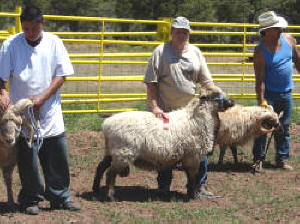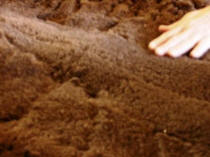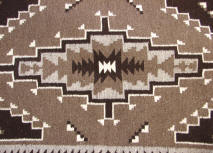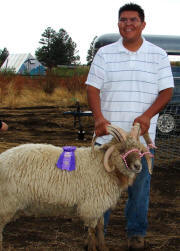Brief History of
Navajo-Churro Sheep
(Note: This is
written from a non-Navajo perspective)
Sheep have been central to stories passed down through generations of Navajo people. The modern day Navajo sheep are believed to be descended from the Churra, an old Iberian breed brought to the Navajo people by the Spanish Conquistadors in the late 1500’s. Through natural selection and breeding, Navajo shepherds developed the Spanish Churra Sheep into a land-race with distinct genetic characteristics and hardiness suited to the rugged Colorado Plateau. According to Navajo people, they have ALWAYS had sheep. Their sheep are considered to be gifts from Talking God and are often refered to as "walking food." Navajo, Hispanic and other American sheep producers participate in the annual Navajo-Churro Sheep Show at Sheep is Life 2007.
 Sheep show at Sheep is Life 2007
Sheep show at Sheep is Life 2007
Sheep became the mainstay of Navajo people, providing food and fiber. The fleece has an inner layer of medium to fine fibers with an outer fleece of coarse fibers up to 12 inches. This unique combination of fiber sizes, the low lanolin content and wonderful colors makes Navajo Churro wool and excellent choice for weaving rugs, felting, rope-making, and for outer garments.
The meat is "sweet" in flavor compared to commercial breeds. It is tender and captures the flavor of the rangeland or pasture it is raised on. Because Navajo-Churro's put most of their fat around their organs, the meat is more lean than other breeds. They finish well on grass and rangeland. Because they mature more slowly they will be classified as lambs well over one-year in age.
Prior to confinement on the Federal reservation lands, Navajo herders enjoyed a large area of lush grazing lands stretching from North-Central Arizona to the Rio Grande River in southern Colorado. Many Navajo families maintained a home base where they raised vegetables and corn, while family shepherds moved their flock through a series of summer and winter camps. For example, Navajo trailed their sheep from arid lowlands through the Mancos Valley to graze on summer range in the La Plata Mountains.
The first blow to the Navajo-Churro Sheep came in the late 1850's when thousands the sheep were rounded up by the US Government and shipped west to supply the California Gold Rush. Then in 1863, retribution for continued Navajo depredations, Colonel Kit Carson, under General James H. Carleton along with 700 troops, marched into the heart of Navajo country. Carson began a systematic campaign of destroying all Navajo means of livelihood. They tore up cornfields, burned peach orchards, killed horses, and slaughtered thousands of sheep. \
Eventually Navajo people were starved into surrendering. What were left of their sheep were left behind by Navajo people forced on to the "Long Walk" to prison camp at Fort Sumner, NMT or Bosque Redondo. The Navajo way of life was altered from pastoral herders to sedentary prisoners. Upon their release from interment in 1868, Navajo were given commercial breed such as Ramblet and Merino to return home with.
The disruption of traditional stewardship and grazing patterns led to season-long grazing of reservation lands some areas, while other areas received no grazing. Weather and geologic gully events in the late 1800’s contributed to a decline in the rangeland health, and disrupted traditional irrigation systems. Navajo people began to struggle with a growing population, reduced summer grazing areas and less irrigated land. In addition the so called modern sheep breeds did not do as well as the Navajo-Churro Sheep and took more to land feed. To confound the situation, wild game populations were depleted leading to further decline in ecosystem health.
Most Navajo sheep production was small scale. Families participated in a subsistence lifestyle and economy which flourished at times. The added value of Navajo Rugs brought cash to families for products they could not produce for their selves. This cash flow increased in importance as a growing population of Navajo became dependent on outside supplies of food and necessities.
In the 1900's further stock reductions were imposed by the US Bureau of Indian Affairs who’s agents shot most of the remaining sheep in 1932 for the sake of improving the rangeland and removing the “ugly” Navajo-Churro sheep. Navajo families watched in horror as their “life” was destroyed and then dumped into gullies to rot.
English words cannot do justice in describing the value sheep have had in the Navajo economy, spirituality and ways of life. Ripple effects shot through their society rendering them ever more dependent on the US Government and non-agricultural sources of income. As their agrarian way of life declined, so did the health of their land and well-being of their people. Many elders have told us that "when the sheep left the land, the water went away, the grass died and now the people have left."
By the early 1970’s an estimated 200 survivors of the original Navajo-Churro Sheep stock, mostly in isolated villages and remote canyons of the Navajo Indian Nation. Dr. Lyle McNeil, sheep husbandry specialist with the Utah State University, fell in love with the Navajo-Churro Sheep and has dedicated his life to the recovery of breed genetics and its return to the Navajo people. He founded the Navajo-Churro Sheep Project which, along with support of other organizations and dedicated breeders, brought the sheep back from the brink of extinction.
Small scale sheep producers are critical to the survival of the Navajo-Churro and genetic diversity in the breed. Today there are Navajo-Churro Sheep breeders scattered across the United States, with a concentration of breeders in the Four Corners region which includes the Navajo Nation and Hispanic communities.
A registry is maintained by the Navajo-Churro Sheep Association. Since the 1970's Navajo Churro Sheep numbers have increased. The American Livestock Breeds Conservancy has move them from their "critical" list with fewer than 200 annual registrations to their "threatened" list with fewer than 1000 annual registrations.
Diné be iiná - the Navajo Lifeway, a grassroots, nonprofit organization founded in 1991, works to restore the balance between Navajo culture, life, and land. The American Livestock Breed Conservancy assists in promoting conservation of the breed. Each year Dine Be Iina hosts Sheep Is Life, a Celebration of Traditional Weaving & Shepherding Cultures. Sheep is Life 2011 will be held June 20-25th in Tsaile Arizona (near Canyon De Chelly) at the Dine' College Campus. Click here for details.


Navajo Churro Wool is excellent for weaving the famous Navajo Rug
For More Information
Slow Food USA Navajo-Churro Sheep Presidia
Dine Be Iina. Find out about Sheep Is Life 2011
Article Links
Slow Food Events
We have Served
Irrigation Water:
Handle
with Care.

Dr. Lyle McNeal at Sheep Is Life 2007 Tsaile AZ, recognizing the 30th anniversary of the Navajo Churro Sheep Project
The animal holocaust...
"Tragically the Navajo-Churro nearly became extinct during the past century through federal management policies during the 'Stock Reduction' era which was covered up for decades and unknown only to those who lived though it. Whole flocks where called to various locations and exterminated by gun fire. The government promised payments for livestock losses, however they have never been fully compensated to this day. The Churro was targeted for extermination as they were considered a "scrub" and "unimproved" sheep and needed to be terminated by the agents. No thought was given to the value of their wool for cultural weaving or their proven adaptability to the harsh environment. Slighty over 1 million sheep and goats were killed during this era. You can still find remains of all those livestock exterminated. By 1972 there were less then 450 head of Navajo Churros left compared to the thousands that roamed before."
From the Navajo-Churro
Sheep Project
"Sheep in every essence an important part of our culture and traditions. It is important to celebrate our sheep traditions and our lifeways. Our Sheep Is Life Celebration re-centers us in the cosmos of our universe; it is our blessingway ceremony for our continuance here on earth, and for the next generations to come."
Roy Kady, Master Weaver & former President of DBI

Jay Begay Jr. with his Four Horn Navajo-Churro Ram, grand champion winner at the Navajo Churro Sheep Association Annual Meeting in Flagstaff AZ 2006.
"These sheep with their long staple of protective top coat and soft undercoat are well suited to extremes of climate. Some rams have four fully developed horns, a trait shared by few other breeds of the world. The Navajo-Churro is highly resistant to disease, and although it responds to individual attention, it needs no pampering to survive and prosper. The ewes lamb easily and are fiercely protective. Twins and triplets are not uncommon. The flavor of the meat is incomparably superior, with a surprisingly low fat content."
From Navajo-Churro Sheep Association Website
